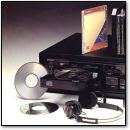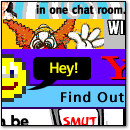 I found myself up in Boone, NC last week at a recently opened Goodwill store. Upon arriving, I quickly made my way back to the electronics section. The place was packed with an unusual surplus of wireless 802.11g network routers — something I’d never seen before in a thrift shop. Most of the items were overpriced, though.
I found myself up in Boone, NC last week at a recently opened Goodwill store. Upon arriving, I quickly made my way back to the electronics section. The place was packed with an unusual surplus of wireless 802.11g network routers — something I’d never seen before in a thrift shop. Most of the items were overpriced, though.
Among the dozen TVs and broken stereos on the sagging back shelves, I found a few gems. In the end, I walked away with a new, in-box controller for the forgettable HyperScan video game system ($2), a shrinkwrapped copy of Microsoft’s Return of Arcade ($4), and my most interesting find, a VTech PreComputer 1000 ($4). Believe it or not, but I’ve actually wanted a VTech Precomputer for some time. A handful of different toy and electronics companies produced a whole class of “educational” or kids’ computers in the 1980s that I’d like to collect. Most of the more sophisticated models have some version of BASIC built in, and the VTech PC1000 is no exception.
 Back in the day, the BASIC programming language (or even Logo — remember the turtle?) was considered the best way to teach kids how to use a computer. They called the push to teach ordinary people how to use these machines “computer literacy” like we do today, but the methods of obtaining that literacy were different. For a time in the late 1970s and early 80s, educators, politicians, technologists, and pundits in major publications around the U.S. worried that every citizen would have to know how to program a computer or they’d be left out of the computer revolution, and thus, the future. After all, if you want to tell a computer to do something, you have to program it, right? How else are you going to get it to do what you want? It seems strange to us now that they didn’t realize that we’d all be running other people’s programs instead (Microsoft did, of course). That popular perception began to shift after the release of the Macintosh in 1984, but the change didn’t fully get here until the mid-1990s. Now we teach people how to use Microsoft Word. By golly, if someone doesn’t know how to program complex and obtuse Word macros, how will they ever be able to create a competitive résumé? In a way, not much has changed.
Back in the day, the BASIC programming language (or even Logo — remember the turtle?) was considered the best way to teach kids how to use a computer. They called the push to teach ordinary people how to use these machines “computer literacy” like we do today, but the methods of obtaining that literacy were different. For a time in the late 1970s and early 80s, educators, politicians, technologists, and pundits in major publications around the U.S. worried that every citizen would have to know how to program a computer or they’d be left out of the computer revolution, and thus, the future. After all, if you want to tell a computer to do something, you have to program it, right? How else are you going to get it to do what you want? It seems strange to us now that they didn’t realize that we’d all be running other people’s programs instead (Microsoft did, of course). That popular perception began to shift after the release of the Macintosh in 1984, but the change didn’t fully get here until the mid-1990s. Now we teach people how to use Microsoft Word. By golly, if someone doesn’t know how to program complex and obtuse Word macros, how will they ever be able to create a competitive résumé? In a way, not much has changed.
 Anyway, back to the PreComputer. I disassembled the unit today to see what makes it tick. As I suspected, the unit’s CPU is a Z-80 clone, the Toshiba TMPZ84C00AP. I also spotted the prominently marked Video Technology (VTech) ROM on the motherboard which contains built-in trivia games in subjects like history, geography, and science, calculator functionality, Hangman, and a typing course. One of the rubber-button options on the PC1000 is “Computer Drill,” which lets you look at nine built-in sample BASIC programs or program in “Pre-Basic 1.0” yourself. Although the PC1000’s twenty-character, one line LCD display is quite limiting, it’s still a compelling feature that’s fun to play with. And heck, the thing has an impressive full-stroke QWERTY keyboard with insert and delete keys. It’s almost as if the PreComputer’s designers were begging for their creation to be used for more than meets the eye.
Anyway, back to the PreComputer. I disassembled the unit today to see what makes it tick. As I suspected, the unit’s CPU is a Z-80 clone, the Toshiba TMPZ84C00AP. I also spotted the prominently marked Video Technology (VTech) ROM on the motherboard which contains built-in trivia games in subjects like history, geography, and science, calculator functionality, Hangman, and a typing course. One of the rubber-button options on the PC1000 is “Computer Drill,” which lets you look at nine built-in sample BASIC programs or program in “Pre-Basic 1.0” yourself. Although the PC1000’s twenty-character, one line LCD display is quite limiting, it’s still a compelling feature that’s fun to play with. And heck, the thing has an impressive full-stroke QWERTY keyboard with insert and delete keys. It’s almost as if the PreComputer’s designers were begging for their creation to be used for more than meets the eye.
I don’t have the manual for the PreComputer, so I have no idea if it can save your programs temporarily in memory, or the extent to which its interpreter supports traditional BASIC commands. I’d particularly like to know how to print to the LCD screen without the automatic pause after each line, if that’s possible. If anyone has a copy of the manual for this and can scan it or type it up for me (especially the section on BASIC), I would be much obliged. Did anyone out there have one of these as a kid? I’d love to hear from you in the comments section.
[ Update: 07/30/2007 – Many generous thanks to Chris Ball for obtaining, scanning, and providing the BASIC section of the PreComputer 1000 instruction manual. You can download all the pages in high resolution JPEG format here (25 MB). Be warned, though: the file is big. Thanks again, Chris! ]
 A couple weekends ago, I made the requisite annual trek to RARSfest, my local hamfest of choice, which takes place on the NC State Fairgrounds. You might remember my in-depth slideshow on a similar hamfest adventure two years ago. Well, this year I decided to take a few shots of the ‘fest again, and I thought you might enjoy them. So hop in the HamCar, and we’ll take a quick ride through RARSfest 2008.
A couple weekends ago, I made the requisite annual trek to RARSfest, my local hamfest of choice, which takes place on the NC State Fairgrounds. You might remember my in-depth slideshow on a similar hamfest adventure two years ago. Well, this year I decided to take a few shots of the ‘fest again, and I thought you might enjoy them. So hop in the HamCar, and we’ll take a quick ride through RARSfest 2008.


 Yesterday afternoon, I drove to a local
Yesterday afternoon, I drove to a local 
 Much to the mixed delight/chagrin of my wife, I doodled on Deluxe Paint with the mouse and tried various games on disk every day for about three weeks while eating breakfast. Alas, after about a month in the culinary limelight, the Kitchen IIe’s novelty has finally begun to wear thin. It will soon move on to another table, but I plan to keep this “school system” together with all its original parts so it will remain a functional example of 1980s educational computing.
Much to the mixed delight/chagrin of my wife, I doodled on Deluxe Paint with the mouse and tried various games on disk every day for about three weeks while eating breakfast. Alas, after about a month in the culinary limelight, the Kitchen IIe’s novelty has finally begun to wear thin. It will soon move on to another table, but I plan to keep this “school system” together with all its original parts so it will remain a functional example of 1980s educational computing.






 I had already been collecting computers for at least two years when I saw the machine, and I was always on the lookout for more additions to my collection. I had heard of a little-known machine called the “Lisa” that Apple released somewhere between the Apple III and the Macintosh, but I had never seen or used one. So when I spotted the Lisa in the library that day, it was an epiphany to me — the Apple story was vividly coming together in my brain. Knowing that the Lisa (a Lisa 2, as it turned out) in the school library was obsolete, I feared that the librarians wouldn’t know what to do with it and would throw it away. I had to take action, but I was painfully shy, and I was only about thirteen or fourteen years old. I was afraid to ask them about the computer because I figured they wouldn’t take me seriously. So I convinced my mother (the best mom ever) to drive back to the library after school and ask the librarians if we could buy the Lisa from them. The librarians had to decline the offer, since it had been donated to the library and was property of the county school system. Sadly, I fear that the Lisa in the library probably met a nasty fate not too long after that incident — a victim of short-sighted middle school bureaucracy.
I had already been collecting computers for at least two years when I saw the machine, and I was always on the lookout for more additions to my collection. I had heard of a little-known machine called the “Lisa” that Apple released somewhere between the Apple III and the Macintosh, but I had never seen or used one. So when I spotted the Lisa in the library that day, it was an epiphany to me — the Apple story was vividly coming together in my brain. Knowing that the Lisa (a Lisa 2, as it turned out) in the school library was obsolete, I feared that the librarians wouldn’t know what to do with it and would throw it away. I had to take action, but I was painfully shy, and I was only about thirteen or fourteen years old. I was afraid to ask them about the computer because I figured they wouldn’t take me seriously. So I convinced my mother (the best mom ever) to drive back to the library after school and ask the librarians if we could buy the Lisa from them. The librarians had to decline the offer, since it had been donated to the library and was property of the county school system. Sadly, I fear that the Lisa in the library probably met a nasty fate not too long after that incident — a victim of short-sighted middle school bureaucracy.




